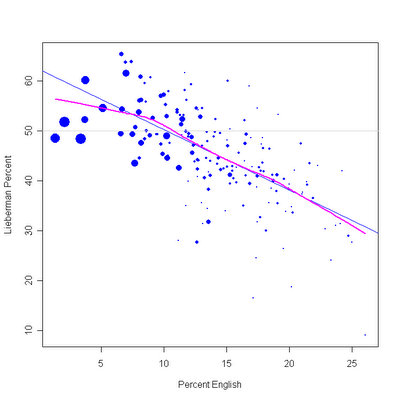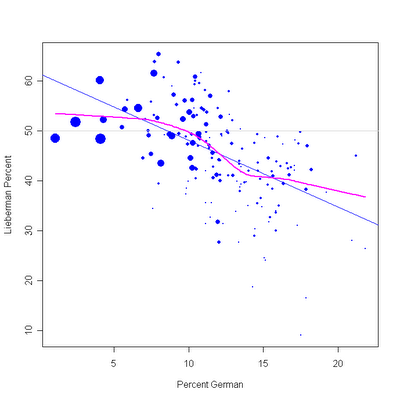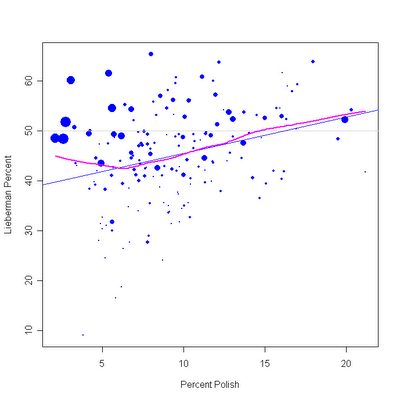
Read the names of the Connecticut towns and you'd certainly think you were in England. Avon, Bridgewater, Bristol, Colchester, Essex, New Britain, New London. That ancestry had quite a role to play in Lamont's victory over Lieberman last night. The plot above shows the Lieberman vote share by the percent identifying their ancestry as "English". All data are at the town level, and the votes are based on complete returns as reported in the Courant.
An important caveat here. These are "ecological" relationships, meaning we are looking at how the vote varies by the concentration of groups within towns. This does NOT mean that individual members of those groups voted for one candidate. It is empirically possible, and is not infrequently the case, that these relationships can be misleading. For example, it is possible that Lamont did well in "English" areas, yet in those areas got no votes at all from "English" individuals. So DO BE CAREFUL in concluding that these relationships hold at the individual level. They may not. Think instead of these relationships as reflecting the relationship between the makeup of places and their votes, not necessarily the votes of specific ethnic or nationality groups. To assess the latter, we would have to have individual level data (or use estimation techniques that are beyond my willingness to work that hard right now!).
Between the least English and most English areas is a gap of some 25 percentage points in favor of Lamont, one of the strongest effects I've found. Further this effect is fairly close to linear above 7% English. I showed here that Lamont did best in the most white towns, but here the evidence is clear that that support was also concentrated by family origin.
The second strongest gradient is among areas with high concentrations of German ancestry, as seen below. Here the total effect is not as great, but still covers a range of some 15 percentage points with Lieberman doing best (about 53%) in the least German areas, and Lamont best (about 60% or above) in areas with the most people of German descent.

The Irish areas (see below) were also somewhat drawn to Lamont, though the Hotline on Call notes some areas that are exceptions to this. The gradient here is only a little less than the German one, about 12 points from least to most Irish concentration.

Lieberman gained strength in areas with high concentrations of Italian and Polish descendants.

As Italian concentration goes from 15% to 30% Lieberman gains about 12 points of support. Beyond that the line continues to rise, but that is driven by few data points so let's be cautious about those few areas.
There are fewer Poles, but the effect is about the same, and a bit more regular. From about 6% to 20% Polish Lieberman gains about 12 points as well.

There are somewhat smaller gains for Lieberman in areas with high French or French canadian populations. While fairly clear, the gains are less than 10 points across a range of concentration.


Ancestry plays a complex role in American electoral alignments. While not the primary structuring mechanism, long held attachments help structure political conflict and attitudes in ways that continue to resonate long after immigrant populations have settled. In this election we see those old ties still having their way with the structure of political choices.
I've also discussed the effects of socio-economic status and race in another post here.
Click here to go to Table of Contents